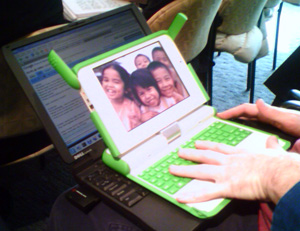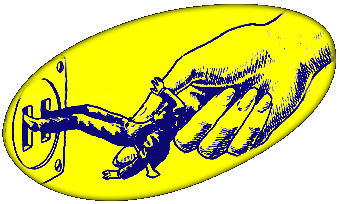
Your dog wants you to switch the lights out when you have finished in there.
Check out these rather nice ads from this French energy company.

 Nice set of Hessian crucibles.
Nice set of Hessian crucibles.


 "Negroponte says that the first working models, so-called B machines, will come off the assembly line in November, after which they'll be put through a torture course of testing in five developing countries--Brazil, Argentina, Libya, Thailand, and Nigeria--to see how they hold up. And even if they do work, the task of persuading governments to buy them still remains. Negroponte has made real progress on this front. In October, Libya signed a memorandum of understanding that effectively commits it to buying a million laptops, assuming the B machines pass their tests, and the other four test nations seem nearly as likely to sign up if the machines work as planned. But five million laptops is, by OLPC's self-defined standards, just a start."
"Negroponte says that the first working models, so-called B machines, will come off the assembly line in November, after which they'll be put through a torture course of testing in five developing countries--Brazil, Argentina, Libya, Thailand, and Nigeria--to see how they hold up. And even if they do work, the task of persuading governments to buy them still remains. Negroponte has made real progress on this front. In October, Libya signed a memorandum of understanding that effectively commits it to buying a million laptops, assuming the B machines pass their tests, and the other four test nations seem nearly as likely to sign up if the machines work as planned. But five million laptops is, by OLPC's self-defined standards, just a start."







 1784, "one who has a taste for (something)," from Fr. amateur "lover of," from O.Fr., from L. amatorem (nom. amator) "lover," from amatus, pp. of amare "to love." Meaning "dabbler" (as opposed to professional) is from 1786.
1784, "one who has a taste for (something)," from Fr. amateur "lover of," from O.Fr., from L. amatorem (nom. amator) "lover," from amatus, pp. of amare "to love." Meaning "dabbler" (as opposed to professional) is from 1786. c.1225, "vows taken upon entering a religious order," from O.Fr. profession, from L. professionem (nom. professio) "public declaration," from professus (see profess). Meaning "occupation one professes to be skilled in" is from 1541; meaning "body of persons engaged in some occupation" is from 1610; as a euphemism for "prostitution" (e.g. oldest profession) it is recorded from 1888. Professional (adj.) is first recorded 1747 with sense of "pertaining to a profession;" 1884 as opposite of amateur. As a noun, it is attested from 1811. Professionalism is from 1856.
c.1225, "vows taken upon entering a religious order," from O.Fr. profession, from L. professionem (nom. professio) "public declaration," from professus (see profess). Meaning "occupation one professes to be skilled in" is from 1541; meaning "body of persons engaged in some occupation" is from 1610; as a euphemism for "prostitution" (e.g. oldest profession) it is recorded from 1888. Professional (adj.) is first recorded 1747 with sense of "pertaining to a profession;" 1884 as opposite of amateur. As a noun, it is attested from 1811. Professionalism is from 1856.